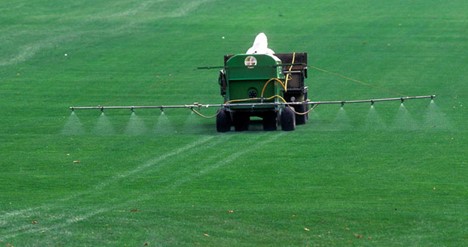
Golf course superintendents set the stage for the game of golf – a stage made almost entirely out of living plants. These plants are forced to grow in unnatural ways and need to endure the daily onslaught of hackers on top of everything that Mother Nature can throw at them.
Conditioning these living playing surfaces for the game of golf day in and day out, is really like hitting a moving target. Some days that range picker is working the exact yardage for the club you have in your hand and you can’t help but light the poor kid up, and some days he’s just a little bit out of reach.
Being successful at meeting the demands of our customers as golf course superintendent requires making full use of all the clubs in our bag, and making well informed decisions around the use of pesticides.
When I made my decision to pursue a career in the profession, I was not really aware of the role that chemicals played in the production of high-end playing surfaces. I watched the Masters and certainly understood that the use of fertilizer and water were critical to maximizing the growth habit, desired form like Bonzai, producing the dense canopy dwarf plants, but I did not immediately associate that wonderfully uniform green surface with the use of chemicals.
It really wasn’t until I was in school at the University of Guelph in the mid ‘90s that the challenges of protecting a high value perennial crop from numerous fungal diseases, feeding insects, and competing weeds, became apparent. While so much of what we do is about growing strong healthy plants, the use of plant protectants, yes, pesticides, is required to varying degrees depending on the expectations of the users (customers, members, owners).
Many of the challenges we face become routine or predictable as a result of weather patterns and changing of the seasons, and as a result we know we will be in a position where making an application of a pesticide is going to be necessary. For example, we know that winter comes every year (to at least some degree) and the use of a fungicide to provide protection from snow mould on finer playing surfaces, such as greens, is going to be required.
Now, thankfully, the golf course management industry is dynamic and continues to evolve, largely driven by scientific research and innovative superintendents. Over the last decade we have seen substantial progress, greatly improved understanding of key diseases, insects, and weeds, resulting in the development of better tools and strategies for pest suppression without chemicals.
At the same time, some of the more toxic chemicals that were relied upon in the past have been removed from the market, or restricted, while effective new chemistries with much better environmental and toxicological profiles have been brought to market. We have to handle the chemicals in order to apply them, and golfers choose to accept a certain level of exposure by setting foot on our courses, so it is in our own best interest to use as little as possible and make sure we are making safe choices as we make an application.
Back in 2010, as municipal and provincial governments were scrambling to deal with the public outcry over pesticide use and debating local level bans, it really seemed as though the golf industry was headed for monumental change and a life without the ability to use a key tool in our toolbox. I wrote an article back then about urging other superintendents to be proactive, and to position themselves to stand up to public scrutiny by building more benign pest control programs using a tool called the EIQ calculator.
In a nutshell, the EIQ calculator gives you a simple number or score for a product as it would be used on the course, essentially the toxicity times the amount of active ingredient applied, thus making it easy to compare one product against another.
The way I like to use the EIQ calculator is in setting out a plan in the offseason, so that in the heat of the battle when the time comes to push the button, a well-reasoned choice of product has already been made. A choice that adds consideration for human health and the environment to the list of other factors being considered in the decision-making process. While the public scrutiny really never materialized over the last decade the way many thought it would, the central theme of making well informed decisions, and looking at the toxicology and environmental profile of the products we are choosing between, remains valid today.
Luke Paddle
In my twenty plus years in the business I have been part of the leadership team at courses in London, Muskoka, and the Kawartha regions, as well as the GTA. Some of my more interesting experiences include: cutting greens at the 2017 US Open at Erin Hills; playing a key role in the ‘grow-in’ of 69 new greens; and hosting the nationally televised Telus Skins Game and a Canadian Tour event a few weeks apart.
After almost 8 seasons as an Assistant Superintendent at Oakdale Golf & Country Club, I have recently made the move to Superintendent at Dragon’s Fire Golf Club north of Hamilton. I look forward to many years at the helm, leading the team to a well-earned reputation for outstanding conditioning.











